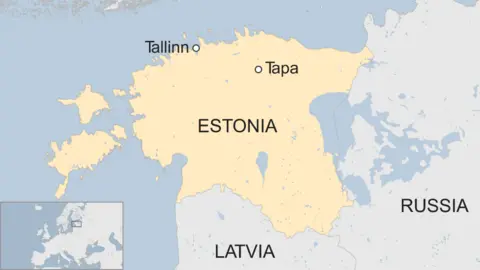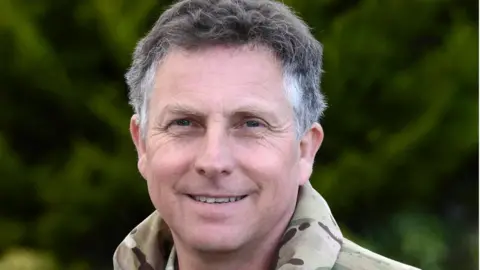Nato sends 'alive and strong' message from Estonia

 Reuters
ReutersThe Estonian town of Tapa is about an hour and half's drive eastwards from the capital Tallinn. Tapa owes its existence to the fact that it sits at an important railway junction. It bears all the hallmarks of an old Soviet garrison town - there was indeed a Russian air base here during the Cold War.
But today, sitting less than 150km (93 miles) from the Russian border, it is the base for a Nato battle group - here, according to the alliance, to reassure the Estonians and to demonstrate Nato's solidarity to Moscow.
The decision to deploy Nato troops eastwards - the closest its bases have ever come to Russian territory - came in the wake of Russia's seizure of Crimea and its military operations in eastern Ukraine. Many of the alliance's northern and central European members were alarmed, especially the Baltic republics, whose territory, like that of Ukraine, was once part of the Soviet Union.
At its Warsaw Summit in 2016, Nato agreed to establish what it called "an enhanced forward presence" with multi-national battle groups deployed in each of the three Baltic states and another in Poland.
The UK commands the Nato battle group in Estonia. It is based on a single British infantry battalion - currently 5 Rifles - with Warrior armoured vehicles, and it incorporates a company of French infantry. They are supported by a small number of British Challenger and French Leclerc tanks. There is also a small complement of artillery, engineers and other supporting arms.
The unit - about 1,000-strong - has only been fully operational since the middle of last month. It forms part of an Estonian brigade whose main base is also in Tapa and from here smaller units are deployed on exercises.
I visited the base along with the head of the British army, Gen Sir Nick Carter. Asked about the Nato troops' mission in Estonia, he acknowledged it was a complex mix of deterrence and training.
"So much of what we're doing here is messaging," he told me.
"You are making a point to Nato allies - you are providing reassurance to them that alliance cohesion is there, it's alive and strong, but you are also making the point to anybody who might wish to oppose that, that this cohesion is the centre of gravity.
"The act of training together, the act of being ready together, of being prepared, sends a message."

For the British Army it is a question of learning new skills or rather of re-learning them after years spent on counter-insurgency operations in Iraq and Afghanistan.
Gen Carter told me that he hoped the current mission would evolve and develop.
"I think what we would like to do," he said, "is to connect it across borders, [to see] how it plays into the Canadian-led battle group in Latvia and how it plays perhaps into what is being done in Lithuania, how all of that is connected together, and how all the Nato command and control process works above it."
"All of those things need to be developed and tested," he told me, and emphasising the point about re-learning old skills. "I think what we are learning from all this are the things that we forgot when we went campaigning in about the year 2001."
 Reuters
ReutersThese multi-national battle groups are relatively small - only about 1,000-strong. But Gen Carter told me that he hoped to move additional equipment or troops to Estonia from time to time to practise all of the procedures needed to reinforce this battle group speedily.
"We would very much like to test the land line of communication from our mounting bases in Germany, forward into the Baltics, and we would absolutely like to test what it would be like bringing in reinforcing capabilities - the signature equipments that are appropriate to show how you would reinforce and to understand what would happen."
"It's great training for us," he said.
"We used to be extremely good at this in the Cold War. We absolutely understood how you would load rail flats and move across borders and all of those sorts of deep logistics systems and we want to be good at that again. We didn't have to do it in Iraq and Afghanistan in the same way. It's the sort of skill sets you would expect an expeditionary army to want to be able to do effectively."
Prior to the battle groups deployment there were concerns that the Russians might seek to compromise some of the foreign troops arriving in Estonia. So I asked Gen Carter if there had been any discernible sign of Russian activity of this sort.
"So far," he answered, "absolutely nothing. We were always conscious that if people wanted to make mischief that was always possible. What's been impressive to me has been the discipline that our battle group has shown here across all of the multi-national elements. That discipline has probably provided a good framework in which it has been difficult to discredit our activities."
 MOD/Crown Copyright/PA
MOD/Crown Copyright/PAThe thick forests of eastern Estonia - especially once winter approaches - could not be more different to the conditions British troops have been operating in over recent years. This is one of Europe's historic battlegrounds - strategic terrain sandwiched between the Gulf of Finland and the waters of Lake Peipus.
There were battles here in the Great Northern War in the 1700's as Russian troops swept westwards in an effort to challenge the Swedish empire - Estonia was a Swedish possession in those days.
There were brutal battles here too in 1944 as the German invaders desperately sought to stem Soviet offensives.
Nobody today really expects conflict but at a time when the dividing line between war and peace is becoming ever more fuzzy, this is now Nato's new front line in a new struggle that some Russian generals believe has already begun.
